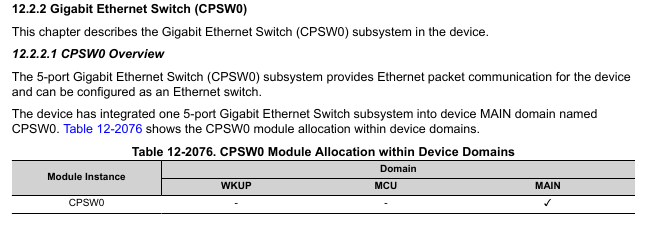Hi,
I am currently trying to understand the CPSW subsystem of the TDA4VM device, and have the following questions:
1) in the TI QNX PSDK 07.02 documentation, the CPSW9G driver is described as:
"The CPSW9G DEVNP network driver implemented as “virtual” driver that communicates with the Ethernet Firware Switch firmware running on the R5 core." which gives me the impression CPSW9G is basically a virtual device. However in the CPSW integration guide, it seems that CPSW9G can be implemented/connected to real physical interface. Can someone help explaining how the CPSW9G is configured per default in the TI QNX PSDK and how it can be then used with real physical interface?
2) Does the convention MCU_CPSW0=CPSW2G and CPSW0=CPSW9G always apply everywhere in the documentation?
3) If CPSW2G is basically the ethernet interface of the MCU safety domain, why is it used as the default ethernet interface for both TI QNX PSDK and TI Linux PSDK which concern the Main domain? Why not the CPSW9G in this case?
4) Referring to latest TDAVM TRM, the CPSW0 (or CPSW9G) is described as 5 ports instead of 9 ports interface:
Can someone explain the discrepancy?
Thank you in advance for the reply.


